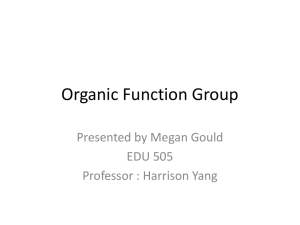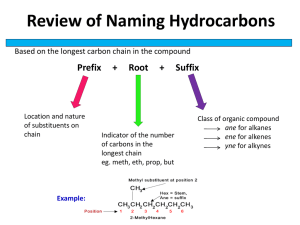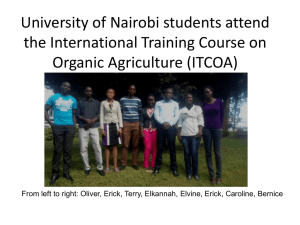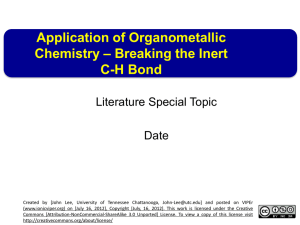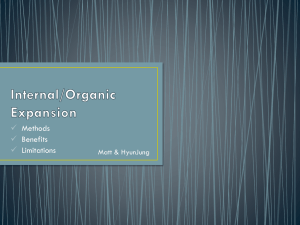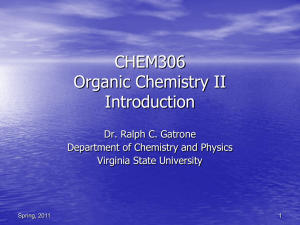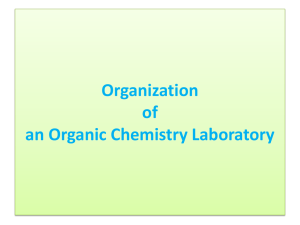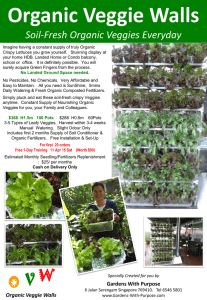Chemistry 30 – Organic Chemistry
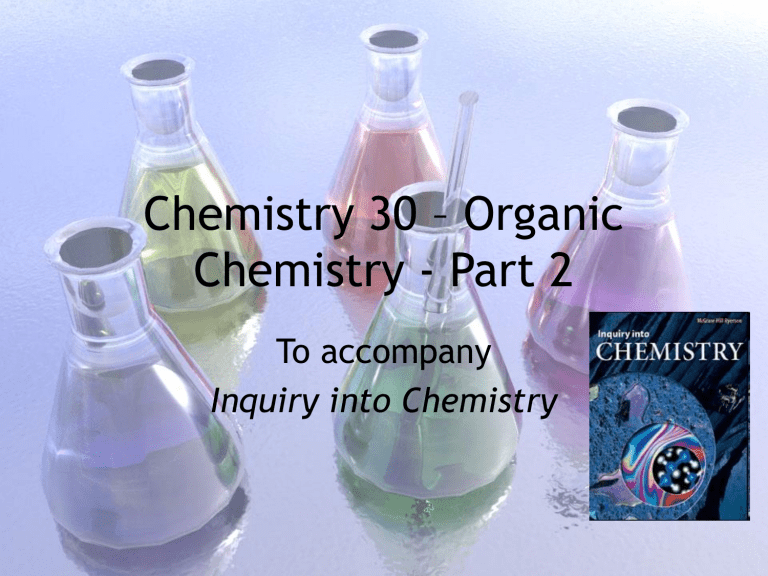
Chemistry 30 – Organic
Chemistry - Part 2
To accompany
Inquiry into Chemistry
Organic Chemistry – 15.1 – Types of Organic
Reactions
• A Combustion Reactions
• We will focus on complete combustions:
hydrocarbon + O
2
(g) CO
2
(g) + H
2
O(g) + energy
• Cellular respiration is a complete combustion (but
H
2
O(l) is produced)
• Many hydrocarbon derivatives also undergo complete combustion
Organic Chemistry – 15.1 – Types of Organic
Reactions
• Do questions 1a, 2, and 3, page 589
Organic Chemistry – 15.1 – Types of Organic
Reactions
• B Addition Reactions
C = C + Y – Z
Y Z
- C – C -
Product has more bonds! Addition
• Addition can occur with alkene or alkyne:
• + water (H OH ) alcohol
• + hydrogen (H
2
) alkane
• + hydrogen halide (H X ) alkyl halide
• + halogen (X
2
) alkyl halide see page
590-1
Organic Chemistry – 15.1 – Types of Organic
Reactions
• Your text has numerous exa mples of addition reactions on page 590 and 591
• Read about trans fats on page 592
A fat molecule:
O
CH
2
– O – C - R R′
H
C = C
H
O
CH – O – C – R
C = C
H
CH
2
O
H
– O – C - R
R′ cis linkage trans linkage fats are tri esters!
Organic Chemistry – 15.1 – Types of Organic
Reactions
• C Elimination Reactions
Y Z
- C – C C = C + Y – Z
• Essentially the reverse of addition – less bonds
• Alcohols undergo elimination to produce water and an alkene
Examples on page 593
• Alkyl halides can undergo elimination to produce alkene and hydrogen halide
Organic Chemistry – 15.1 – Types of Organic
Reactions
• D Substitution Reactions
• Like name implies, something leaves and is replaced by something else
- C – Y + A – Z - C – Z + A - Y
• Examples pages 593 and 594
• Note that for halogens + alkanes, reaction is very slow (essentially doesn’t occur) without presence of ultraviolet light
Organic Chemistry – 15.1 – Types of Organic
Reactions
• Aromatics + halogens will undergo substitution, not addition
Organic Chemistry – 15.1 – Types of Organic
Reactions
• E Esterification
O
R - C – OH carboxylic acid
+ HO - R′ alcohol
O
H
2
SO
4 catalyst
R - C – O - R′ ester
+ HO H water
• Esterification is a type of elimination reaction – water is produced
Organic Chemistry – 15.1 – Types of Organic
Reactions
• Example:
O
CH
3
– CH
2
– C – O - H + H - O-CH
3
H
2
SO
4
Organic Chemistry – 15.1 – Types of Organic
Reactions
• Example:
O
CH
3
– CH
2
– C – O - H + H O-CH
3
H
2
SO
4
CH
3
– CH
2
O
– C – O – CH
3
+ HOH methyl propanoate
• I prefer to write it in reverse direction (alcohol
1 st ) to make naming ester easier
O
H
2
SO
4
O
CH
3
– O – H + H – O – C – CH
2
– CH
3
CH
3
– O – C – CH
2
– CH methyl propanoate
3
+ HOH now ester is written in order of name
Organic Chemistry – 15.1 – Types of Organic
Reactions
• Further esterfication examples on page 595 – 6
• Other examples page 596
• Do Practice Problems 1 – 3, page 596 – 7
• Do WS 15.1.5
• Do Investigation 15.A, page 597
Organic Chemistry – 15.1 – Types of Organic
Reactions
• Summary:
Reaction type
Complete
Combustion
Reactants Hydrocarbon*
+ O
2
Products
Other
Other
CO
H
2
2
(g) +
O(g) or (l)
Addition ene or yne +
HOH, X
2
, HX, or H
2 alcohol, alkyl halide*, alkane
Elimination Substitution Esterification alcohol or alkyl halide alkene + HOH or HX triple or double to single single to double more bonds* fewer bonds* alkane or aromatic + X
2 alkyl halide ester + water slow; needs uv light alcohol + carboxylic acid acid catalyst needed
Organic Chemistry – 15.2 – Polymers and the
Petrochemical Industry
• Bromine test for double bonds
• Bromine, Br
2
, forms a brown solution
(remember electrolysis of KBr(aq)
• If Br
2
(aq) is mixed with an alkene or alkyne, addition will occur and the brown colour will disappear in the aqueous layer
• If Br
2
(aq) is mixed with an alkane or aromatic, substitution (slow) will occur and the aqueous layer will remain brown…………..
Organic Chemistry – 15.1 – Types of Organic
Reactions
• Read “Octane-Enhancing Compounds” page 599 and
• “Replacing CFC’s” page 600
• Section 15.1 – oral review – question 1 reaction type
Organic Chemistry – 15.2 – Polymers and the
Petrochemical Industry
• Polymer: a large long chain molecule with repeating units of small molecules called monomers
• Plastics: polymers that can be heated and shaped into specific shapes and forms
• Plastics are always synthetic, though not all polymers are synthetic
Organic Chemistry – 15.2 – Polymers and the
Petrochemical Industry
• Addition polymerization the reaction is an addition reaction as studied earlier
• Example: polyethylene
CH
2
=CH
2
+ CH
2
=CH
2
-CH
2
-CH
2
-CH
2
-CH
2
+ CH
2
=CH
2
- CH
2
– CH
2
– CH
2
– CH
2
– CH
2
– CH
2
– and on and on
Organic Chemistry – 15.2 – Polymers and the
Petrochemical Industry
• Other addition polymers:
2 2 2
2
Cl
2
Cl
2
Cl
Organic Chemistry – 15.2 – Polymers and the
Petrochemical Industry
• Condensation polymerization – water produced
• poly esters and nylons
• polyester example: ester linkage
Organic Chemistry – 15.2 – Polymers and the
Petrochemical Industry
• nylon example: amide linkage: same type of bond present between amino acids in proteins
Organic Chemistry – 15.2 – Polymers and the
Petrochemical Industry
• Do Practice Problems page 606, questions 7-10
Organic Chemistry – 15.2 – Polymers and the
Petrochemical Industry
• Ethene (ethylene) is required for the manufacture of many substances in Alberta’s petrochemical industry
• Eth ane, obtained from petroleum refining is
“cracked” to produce ethene by catalytic cracking:
C
2
H
6
(g) CH
2
=CH
2
(g) + H
2
(g) ethane ethene
• Ethene is used to produce ethylene glycol
(ethane-1,2-diol), polyethylene, and polyvinyl chloride
Organic Chemistry – 15.2 – Polymers and the
Petrochemical Industry
• Manufacture of PVC (polyvinyl chloride):
Step 1:
Cl Cl
C = C (g) + Cl
2
(g) - C – C - (g) reaction type?
• Step 2:
Cl Cl Cl
- C – C – (g) C = C (g) + HCl(g) reaction type?
HCl from step 2 reacted with more ethene to produce more Cl Cl
- C – C -
Organic Chemistry – 15.2 – Polymers and the
Petrochemical Industry
• Step 3:
Cl n C = C
Cl Cl Cl
………. - C – C – C – C – C – C - ……….
polyvinyl chloride
Organic Chemistry – 15.2 – Polymers and the
Petrochemical Industry
• Heath and Environmental Concerns:
Cl
• Viny l chloride: was found in the
1970’s to be carcinogenic. Workers protected today by government legislation
• Manufacture and disposal of PVC may produce dioxins – highly toxic
Biggest source: people burning their own garbage
Organic Chemistry – 15.2 – Polymers and the
Petrochemical Industry
• Plastics do not decay or rot – problems?
• Today: recycling programs – manufacture of useful products from recycled plastics
• Note: recycling is not the cure-all. Reducing and reusing are better solutions. Why?
Organic Chemistry – 15.2 – Polymers and the
Petrochemical Industry
• Natural Polymers
• Carbohydrates: (monomer-glucose) cellulose, starch, glycogen
• Proteins: (monomer-amino acids)
• DNA
Organic Chemistry – 15.2 – Polymers and the
Petrochemical Industry
• Section 15.2 Review, page 614, question 1-6
Organic Chemistry – 15.2 – Polymers and the
Petrochemical Industry

